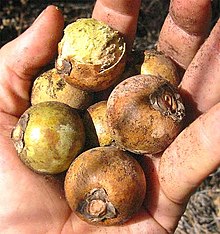bio.wikisort.org - Plant
Acrocomia aculeata is a species of palm native to the Neotropics, from southern Mexico and the Caribbean south to Paraguay and northern Argentina. Common names include grugru palm, gloo gloo, macaúba palm, coyol palm, and macaw palm; synonyms include A. lasiospatha, A. sclerocarpa, and A. vinifera.
The fruit turns yellow when ripe and has a hard outer shell. The pulp is slightly sweet and is extremely slimy and sticky.
Description


It grows up to 15–20 m tall, with a trunk up to 50 cm in diameter, characterized by numerous slender, black, viciously sharp 10 cm long spines jutting out from the trunk. The leaves are pinnate, 3–4 m long, with numerous slender, 50–100 cm long leaflets. Petioles of the leaves are also covered with spines. The flowers are small, produced on a large branched inflorescence 1.5 m long. The fruit is a yellowish-green drupe 2.5–5 cm in diameter. The inner fruit shell, also called endocarp, is very tough to break and contains usually one single, dark brown, nut-like seed 1–2 cm in diameter. The inside of the seed, also called endosperm, is a dry white filling that has a vaguely sweet taste like coconut when eaten.
Ecology
The tree was noted by the English naturalist Henry Walter Bates in his 1863 book The Naturalist on the River Amazons, where he wrote that
[The Hyacinthine Macaw] flies in pairs, and feeds on the hard nuts of several palms, but especially of the Mucuja (Acrocomia lasiospatha). These nuts, which are so hard as to be difficult to break with a heavy hammer, are crushed to a pulp by the powerful beak of this macaw.
— Bates[3]
Uses

The plants inhabit a wide variety of climates and situations; in Paraguay, for example, where it is ubiquitous, it is called the coco paraguayo (Paraguayan coconut), as it is much less common in the rest of the world. It has been suggested that grugru nuts, which come in mass numbers from each tree, can be used in the manufacture of biodiesel. The grugru nut, while very hard, can be sliced into thin circles to be sanded and worn as rings. The trunk of the palm can also be 'milked' to yield a fermented alcoholic beverage known as coyol wine.
References
- Machuca Machuca, K., Martínez Salas, E., Quero, H. & Samain, M.-S. 2022. Acrocomia aculeata. The IUCN Red List of Threatened Species 2022: e.T201622A2709063. https://dx.doi.org/10.2305/IUCN.UK.2022-1.RLTS.T201622A2709063.en. Accessed on 27 October 2022.
- Martius, Historia Naturalis Palmarum 2:66. 1824
- Bates, H. W. (1864). The naturalist on the River Amazons. London: J. Murray. Pages 79–80. (1st (long) ed.) 1863
- Germplasm Resources Information Network: Acrocomia
- PACSOA: Acrocomia aculeata
- Project for Neotropical Fruits: Acrocomia aculeata
- Leuphana Universität, Lüneburg (2013) Macauba - Sustainable Palm Oil
External links
На других языках
- [en] Acrocomia aculeata
[es] Acrocomia aculeata
Acrocomia aculeata o coyol (nahuatlismo de coyolli, "palmera o cascabel"), conocida como cocoyol en la península de Yucatán,[1] bastones de Tabago,[2] palma espinosa de las Antillas,[2] corozo de Colombia y Venezuela,[2] mbocayá, palma de vino, grugru, nuez del Paraguay, totaí en Bolivia; es una planta de la familia de las arecáceas, nativa de ciertas zonas tropicales de América. El aceite de la semilla y la pulpa se utilizan en alimentación y en la fabricación de jabones.Другой контент может иметь иную лицензию. Перед использованием материалов сайта WikiSort.org внимательно изучите правила лицензирования конкретных элементов наполнения сайта.
WikiSort.org - проект по пересортировке и дополнению контента Википедии

